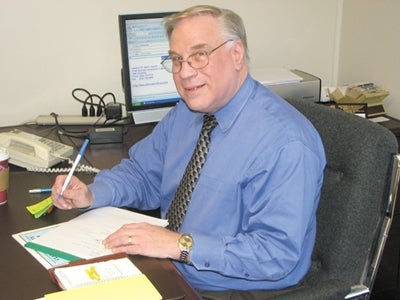Bankers: There's Money To Be Lent In 2010
 Photo/Courtesy
Larry Marsh, director of the central regional office of the Massachusetts Small Business Development Center, which is located at Clark University in Worcester, says 2009 was a banner year for startups.
Photo/Courtesy
Larry Marsh, director of the central regional office of the Massachusetts Small Business Development Center, which is located at Clark University in Worcester, says 2009 was a banner year for startups.
Despite the widespread belief that 2009 was a bad year to start or expand a business, that’s not the standpoint of the Massachusetts Small Business Development Center Network at Clark University in Worcester.
“This was a record startup year for us — with 47 startups going from new energy solar panel installation businesses to corporate people putting out a shingle for consulting work,” said Central Regional Office Director Larry Marsh. “Twenty to 25 percent of them got some form of financing from banks.”
The free program, funded through federal and state grants in partnership with the U.S. Small Business Administration and the Massachusetts Department of Business Development, annually works with 800 to 900 area clients, most in the half-million dollar sales per year target range; most are in the startup stage.
So, Marsh and his colleagues are in many ways on the front lines of business development in Central Massachusetts.
Along with providing technical and marketing assistance, it advises them on how to get capital. Its business clients may need equipment or a building; typically, the places the Clark program lends its efforts to are owner-operated businesses with less than 25 employees.
“We see a market for accessory capital if you’re prepared and have a good proposal,” Marsh said.
Most successful loan applications have happened locally.
“The larger national banks really don’t want to spend the time reviewing a proposal from a small local business,” he said.
“Most of the money is coming from regional banks, who are lending. As evidence, we did $17.9 million in lending for our clients over the past year. Typically, each is for $100,000 to $150,000 of working capital.”
A, B, Cs Of Lending
Now, more than ever, a good business plan is essential in obtaining operating capital.
Steve Mackowitz, vice president of commercial lending for Marlborough-based Digital Federal Credit Union, believes lenders are approving 25 to 30 percent of the amount of loans that they were during the boom years.
Using a high school grading system of A through F, he said, “In the bustling years loan requests that scored an A or B were easily approved. Many Cs also passed the grade if they had a compelling reason as to why they should be eligible for the loan. It was possible that even a few D graded loans were approved based on their collateral strength.”
In today’s market, Mackowitz said, most As and Bs are being approved, with probably only 15 to 25 percent of businesses in that eligibility range.
What makes an “A” borrower?
According to Mackowitz, there are several key ingredients, including a history of earnings and cash flow as well as a strong capital position.
Mackowitz said a “B” borrower has many of the same characteristics as an “A” but may not be as strong, or one of the characteristics was not met but it’s expected they will be corrected shortly.
For instance, he said, “Sales and earnings were down because of the recession but costs have been cut and steps have been made to return to a satisfactory level of profitability.”
Extending Networks
While there’s been some consolidation in the state and the region’s banking market (the number of institutions in Massachusetts has dropped from 181 in 2007 to 172 as of the third quarter of 2009, according to the FDIC), the community banks do remain committed to small businesses and the local economy.
Michael J. Quink, senior vice president and senior business banker for Fitchburg-based Fidelity Bank said his bank is lending and is seeking every chance to expand its market relationships.
“We go through each request with each client and try to make it work for both of us,” Quink explained. “We try to design an approach that matches the request and conforms with credit guidelines.”
Most established businesses arrive at the Fidelity Bank officers with their business plan in hand offering a clear understanding and expectation of where they expect their business to be in the upcoming years.
“We ask them, ‘Where are you going to take your business in six- to 12-months time and where do you expect to be 24 months down the road?’” Quink said.
In making lending decisions, he said, his bank needs to understand where a business has been in the past, what’s changed in the marketplace they compete in, and where they are going as a company.
“It is critical that we understand how they changed, what new changes will be taking place and what the expected outcome will be from the injection of new capital or restructuring of existing loans,” he said. The more open a business owner can be with his bank, the more likely a financing deal can be arranaged.
Seeking Advice
The Worcester region had been receiving a growth in investment for expanded construction and refitting of existing properties prior to the economic downturn.
Richard B. Kennedy, president and CEO of the Worcester Regional Chamber of Commerce, said some of the projects funded prior to that time are still on track but smaller businesses are struggling to get continued funding from financial institutions, especially the larger national banks.
He stressed the importance of area businesses looking to borrow money to utilize the expertise available through programs like the Massachusetts Small Business Development Center Network at Clark University, the United States Small Business Administration Fixed Asset 504 Loan Program through the Worcester Business Development Corporation and the Service Corps of Retired Executives (SCORE).
Brian Goslow is a freelancer writer based in Worcester.









0 Comments